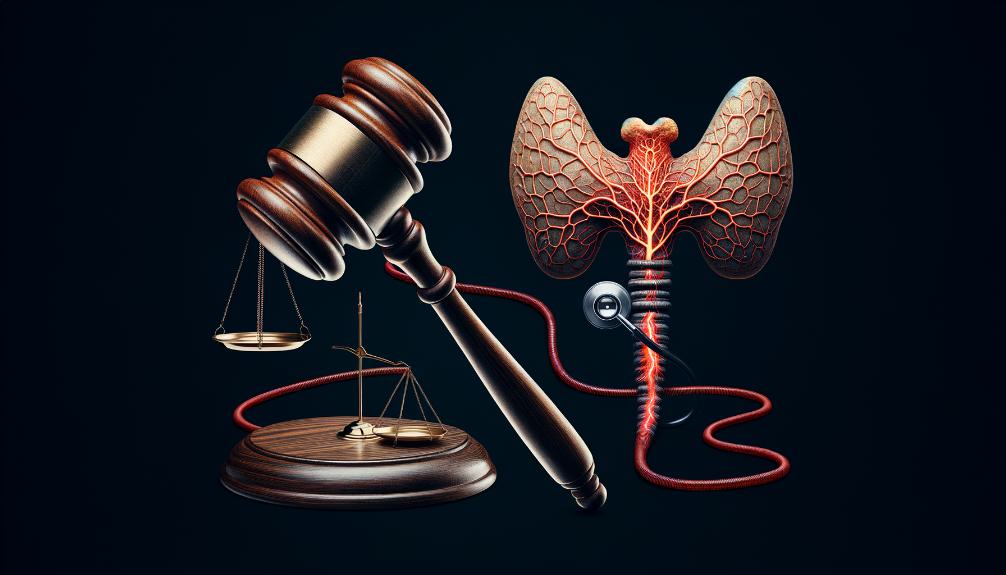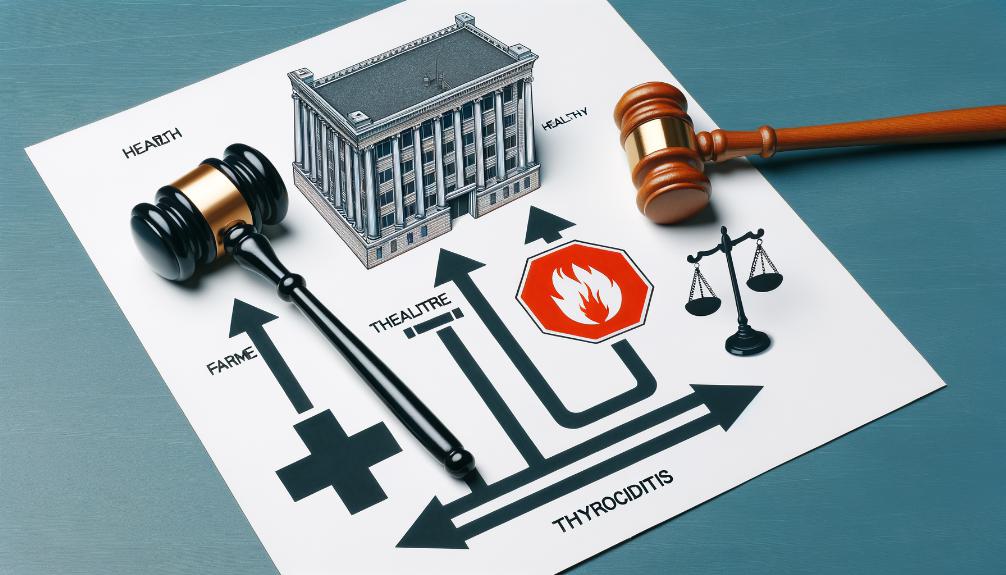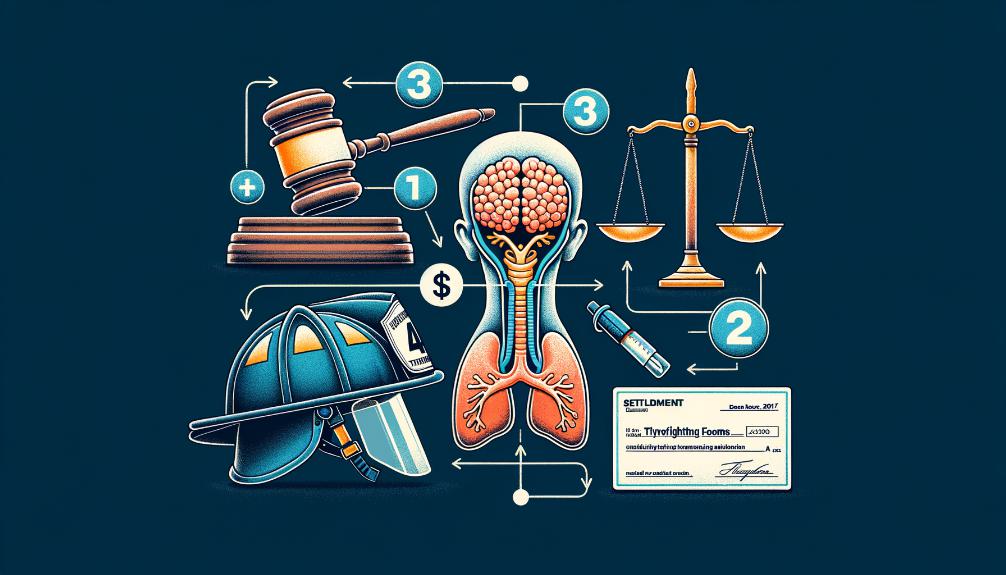Thyroiditis Claims Against AFFF Manufacturers: Settlement Insights
The recent surge in thyroiditis claims against AFFF manufacturers sheds light on the intricate dynamics of legal battles over health issues linked to PFAS contamination. As victims seek compensation for thyroid-related ailments, understanding the nuances of settlement expectations becomes paramount. With compensation figures ranging significantly, the underpinnings of successful claims rest on a robust compilation of medical evidence and exposure histories. This discussion aims to unravel the complexities surrounding these legal proceedings, offering insights into the critical factors that influence settlement outcomes. The evolving landscape of litigation against AFFF manufacturers suggests a compelling narrative that merits further exploration.

Key Takeaways
- AFFF exposure is linked to thyroid diseases, prompting legal claims for compensation.
- Gathering robust evidence is essential for proving the link between PFAS in AFFF and thyroid dysfunction.
- Expected compensation for thyroiditis claims ranges from $300,000 to $450,000, depending on several factors.
- Choosing experienced attorneys in environmental litigation is crucial for navigating settlement negotiations effectively.
AFFF and Thyroid Disease Link

The link between Aqueous Film Forming Foam (AFFF) exposure and the onset of thyroid diseases is increasingly recognized, stemming primarily from the contamination of Per- and Polyfluoroalkyl Substances (PFAS) found in the foam. These chemicals, integral to AFFF's effectiveness in extinguishing complex fires, have been identified as a significant health risk, particularly concerning the disruption of the thyroid hormone system. This disruption is crucial as the thyroid gland plays a pivotal role in regulating metabolism, heart rate, and body temperature.
Firefighters, who are frequently exposed to AFFF in the line of duty, face a higher risk of developing thyroid diseases. Studies have elucidated that PFAS chemicals can accumulate in the body over time, leading to an increased risk of several health issues, including thyroid dysfunction. This understanding has prompted individuals affected by thyroid diseases linked to AFFF exposure to seek compensation for their conditions. The quest for compensation is not merely about the financial aspect but also about holding responsible parties accountable for the PFAS contamination and its life-altering consequences on health.
As awareness grows regarding the health risks associated with AFFF and PFAS, so does the determination of affected individuals to seek justice. This pursuit is underpinned by a growing body of evidence connecting PFAS exposure to thyroid diseases, reinforcing the need for accountability and support for those affected. The move towards seeking compensation and justice reflects a broader acknowledgment of the health risks posed by PFAS contamination and the importance of addressing these risks proactively.
Legal Pathways for Claimants

Navigating the legal pathways for thyroiditis claims against AFFF manufacturers often requires claimants to meticulously gather evidence linking their exposure to the onset of thyroid disease. This process is complex, necessitating a comprehensive approach that includes obtaining expert medical opinions and presenting scientific evidence clearly demonstrating the connection between AFFF exposure and thyroiditis. The legal landscape for thyroiditis settlements is thus highly dependent on the strength and clarity of this evidence.
Claimants embarking on this journey must prepare well-documented cases to stand a strong chance of securing compensation. This compensation is vital, covering extensive medical expenses and compensating for lost wages due to the debilitating nature of thyroid disease. The initiation of settlement negotiations for eligible individuals, expected to begin in 2024, marks a critical phase where the preparation and presentation of cases will determine the outcomes for many affected by AFFF exposure.
The role of legal representation cannot be overstated in this context. Skilled lawyers with experience in environmental and product liability law are crucial for guiding claimants through the intricacies of the settlement process. These legal professionals not only provide the necessary expertise in gathering and presenting evidence but also in navigating the negotiation landscape. Effective legal representation ensures that claimants' rights are protected and maximizes the chances of achieving a fair settlement.
Scientific Evidence Overview

Delving into the scientific realm reveals that PFAS exposure from AFFF significantly disrupts thyroid hormone functions, underscoring the complex relationship between these substances and thyroid diseases such as thyroiditis. PFAS compounds, ubiquitous in Aqueous Film Forming Foams (AFFF) used for firefighting, act as potent endocrine disruptors. They interfere with critical enzymes like thyroperoxidase, pivotal in the synthesis of thyroid hormones. This disruption can lead to a cascade of thyroid-related health issues, including but not limited to hypothyroidism and Graves disease, both of which have been linked to PFAS exposure in recent research.
The scientific evidence pointing to the connection between PFAS exposure and thyroid dysfunction is substantial and growing. Studies have shown that different categories of PFAS in AFFF may have varying effects on thyroid function, further complicating the understanding of their impact on individuals exposed to these chemicals. This variability underscores the necessity of a nuanced approach to examining the relationship between PFAS and thyroid diseases, particularly thyroiditis.
For individuals pursuing thyroiditis claims against AFFF manufacturers, understanding the scientific evidence is paramount. The link between PFAS exposure and an increased risk of thyroid diseases has become a critical component of legal claims, highlighting the need for comprehensive scientific literacy among claimants and their legal representatives. The evidence not only elucidates the mechanisms through which PFAS act as endocrine disruptors but also strengthens the basis for holding manufacturers accountable for their role in exposing individuals to these harmful substances.
Compensation Expectations

Understanding the scientific foundation of thyroiditis claims against AFFF manufacturers sets the stage for discussing the expected compensation for affected individuals. As the litigation landscape evolves, persons suffering from thyroid dysfunction due to AFFF exposure are increasingly seeking justice and financial restitution. The range of compensation for these claims is anticipated to fall between $300,000 and $450,000. This estimation underscores the gravity of the harm inflicted and the recognition of the need for adequate compensation.
The determination of settlement amounts hinges on several critical factors. The severity of thyroid dysfunction plays a pivotal role, as it directly impacts the individual's quality of life and potential for recovery. Additionally, a well-documented exposure history to AFFF chemicals is indispensable for substantiating the claim. This documentation not only serves as evidence of exposure but also helps in establishing a direct link between the AFFF product and the thyroid condition. Age is another consideration, reflecting how the ailment affects an individual's life span and earning capacity.
Negotiations for settlements are expected to kick off in 2024, necessitating thorough preparation from the claimants' side. The complexity of these negotiations highlights the importance of detailed documentation and expert legal assistance. Legal professionals specializing in such cases can navigate the intricate settlement process, ensuring that claimants receive fair compensation. Their expertise in handling the nuances of negotiations and their ability to present a compelling case based on the severity of dysfunction and exposure history are crucial for achieving a favorable outcome.
Selecting Legal Representation

Selecting the right legal representation is a critical step for individuals pursuing thyroiditis claims against AFFF manufacturers, requiring careful consideration of the attorney's expertise in environmental litigation and their track record in similar cases. Skilled attorneys with a deep understanding of the nuances of thyroid disease claims are paramount in guiding clients through the intricate legal landscape, ensuring that all relevant medical records, employment history, and exposure details are meticulously evaluated. This comprehensive preparation is vital for building a robust case against AFFF manufacturers.
The proficiency of legal representation in handling similar lawsuits significantly influences the likelihood of a favorable outcome. The complexity of thyroiditis claims demands attorneys who are not only versed in environmental litigation but also possess a specialized knowledge of the health impacts associated with AFFF exposure. Their expertise in deciphering the technical aspects of such cases and connecting them to the client's condition is crucial.
Moreover, navigating the settlement process in thyroiditis claims against AFFF manufacturers requires a legal team well-versed in negotiation tactics and settlement dynamics. Attorneys experienced in AFFF-related thyroid disease claims are better equipped to manage the settlement process efficiently, ensuring that their clients receive just compensation.
Case Study Highlights

Having explored the importance of skilled legal representation in thyroiditis claims against AFFF manufacturers, we now turn our attention to case study highlights that underscore the complexities and outcomes of such litigation. These cases vividly illustrate the critical role that detailed exposure history and scientific evidence play in securing compensation for thyroid disease resulting from PFAS exposure in firefighting foam.
In one notable case, a firefighter developed thyroiditis after years of exposure to AFFF, a firefighting foam containing harmful PFAS chemicals. The plaintiff's legal team meticulously documented the firefighter's exposure history, linking their thyroid dysfunction directly to their professional use of AFFF. Supported by robust scientific evidence that PFAS exposure can lead to thyroid disease, the legal representation successfully negotiated a settlement between $300,000 and $450,000. This compensation range reflects the severity of the disease and the impact on the individual's quality of life.
Another case study highlights the complexities of proving causation in thyroiditis claims. Despite the known hazards of PFAS exposure, demonstrating a direct link between AFFF use and thyroid disease requires a comprehensive understanding of both legal and scientific realms. Here, effective legal representation was instrumental in navigating these intricacies, guiding the claimant through the settlement process and achieving a favorable outcome.
These case studies emphasize the importance of a well-documented exposure history and the indispensability of scientific evidence in substantiating claims against AFFF manufacturers. They showcase the value of skilled legal representation in overcoming the challenges posed by such litigation, ultimately leading to just compensation for those afflicted by thyroiditis due to PFAS exposure.
Future Litigation Trends

As the legal landscape continues to evolve, future litigation trends suggest a significant focus on thyroiditis claims stemming from PFAS exposure in AFFF. The connection between Aqueous Film Forming Foam (AFFF) and thyroid diseases is becoming increasingly recognized, propelling the surge in litigation related to these health issues. As awareness grows, so does the number of individuals stepping forward to seek compensation for the adverse health impacts attributed to PFAS exposure. This shift marks a pivotal moment in the realm of AFFF lawsuits, highlighting thyroiditis claims as a central concern.
AFFF manufacturers are now facing an uptick in legal challenges as claimants pursue justice for thyroid-related health conditions. The evolving legal pathways are tailored to address the nuanced aspects of thyroiditis claims, ensuring that the specific health impacts of PFAS exposure are meticulously considered. This progression in litigation underscores the necessity for AFFF manufacturers to reassess their legal strategies, as the focus intensifies on thyroid diseases linked to their products.
The shift towards prioritizing thyroid disease claims within AFFF lawsuits indicates a broader trend in environmental and health-related litigation. Settlement insights gleaned from recent cases provide a glimpse into the future, where thyroiditis claims are expected to play a more prominent role. As legal professionals and claimants navigate these complex waters, the landscape of litigation against AFFF manufacturers is poised for significant transformation. This evolution reflects a growing acknowledgment of the severe health implications of PFAS exposure, steering the direction of future litigation towards achieving justice and compensation for those affected by thyroiditis.
Frequently Asked Questions
What Is the Average Payout for the AFFF Lawsuit?
The average payout for AFFF lawsuit settlements is typically within the range of $300,000 to $450,000. This compensation range reflects considerations such as the severity and specifics of the health conditions linked to AFFF exposure.
Is There a Settlement for AFFF in 2023?
In 2023, there has not been a specific settlement for AFFF-related claims announced. Settlement negotiations for AFFF-related thyroid disease claims are anticipated to start in 2024, with the current focus on AFFF firefighting foam cancer lawsuits.
Who Qualifies for the AFFF Lawsuit?
Individuals eligible for the AFFF lawsuit include firefighters, military personnel, and airport workers diagnosed with thyroiditis or related diseases due to PFAS exposure in firefighting foam. Documentation of exposure and confirmed diagnosis are necessary for qualification.
Is the AFFF Lawsuit Legit?
The AFFF lawsuit is legitimate, grounded in scientific evidence that links PFAS chemicals in firefighting foam to thyroid diseases and other health issues. It seeks to hold manufacturers accountable for inadequate safety research and warnings.
Conclusion
In conclusion, the association between Aqueous Film Forming Foam (AFFF) and thyroid disease has catalyzed a series of legal claims against manufacturers. These claims illuminate the complexity of establishing causality and securing compensation for affected individuals. Through a meticulous examination of scientific evidence and legal proceedings, claimants are guided towards achieving just settlements. The anticipated range of compensation underscores the importance of robust legal and medical documentation. Future litigation trends may evolve as further evidence emerges, influencing both legal strategies and settlement outcomes.




